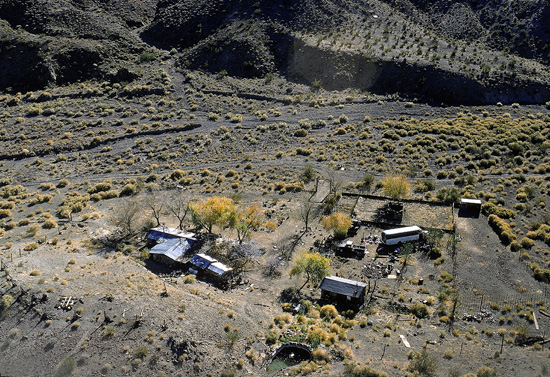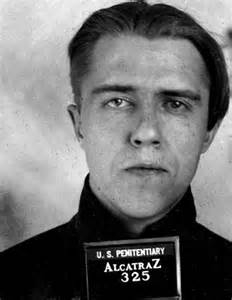Spahn Ranch had previously been used as a western movie set in the 1940’s and 1950’s, and a small part of it was still being used for horse rentals (Rosenberg). On every side of the ranch were tall canyons and natural streams, giving it an air of seclusion, even though the town of Chatsworth was only a few minutes away (Charles Manson). An exciting idea formed in Manson’s head; he wanted to move the Family onto the generous ranch, and didn’t hesitate in doing so (Rosenberg). In his favor was the fact that the owner of the ranch was eighty-one years old and legally blind (Charles Milles). Spahn agreed to let Charlie use the ranch, and Charlie in turn, lent the man the constant care and attention of his female followers (Charles Milles).

Spahn Ranch movie set, the first settlement for the Manson Family
As the Family settled into the ranch, some of Spahn’s hired hands, lured in by the scantily clad females, found themselves part of the group; this was something that Charlie was not happy about (Charles Manson). As well, many male drifters that the group had previously encountered in their travels found their way to the ranch and joined the Family; some of these included Bruce Davis, Steve Grogan, Paul Watkins, and Charles Tex Watson (Charles Manson). These additions to the clan of the male sex constantly put Charlie under pressure, and he felt as though he needed to continuously prove his status (Charles Manson).

Charles Watson aka “Tex”, who played a significant role
in the murderous deeds of the Manson Family
On the ranch, the Family was all about celebrating their newfound freedom (Charles Manson). Meals were made from the discards of local supermarkets; and drug experiments along with open sexuality became top entertainment (Charles Manson). Many babies were born in the months that followed, including another child by Charles, birthed by Sandra Good (Charles Manson). Manson proudly looked after his band of followers, who felt constricted by the confines of society and had turned to the creation of a world of their own (Charles Manson). Charles’ ideas were heartily embraced, and he spent many hours telling them stories about revolution and violence (Charles Manson).
An enthusiastic reader of the Bible, Manson quoted the book of Revelations, and when the Beatles released their album The White Album in 1968, Manson became obsessed with their songs, in particular “Helter Skelter” and “Revolution 9” (Montaldo). He came up with his own interpretation of the lyrics, and using different views from Revelations, created a philosophy that predicted an apocalyptic race war between the blacks and the whites, in which the blacks would win (Montaldo). However, Manson believed that they would rely on himself and the Family to lead them in the new world (Montaldo). He told his followers that they alone would be saved because they would turn to an underground city of gold in Death Valley to save them (Rosenberg). The murders that followed have been thought to be because of this philosophy, and based on Charles’s idea that, since the war that he predicted hadn’t started, they needed to show the blacks how to do it (Rosenberg). However, there are reasons against this theory as well, and while it may have been part of the agenda, it doesn’t seem to have been the only driving force to commit the murders.

The group at Spahn Ranch continued to grow, and with new growth came members of the Straight Satan motorcycle gang (Charles Manson). Drug sales soon resulted in a large influx of money and it was around this time that Charles strayed from his previously peaceful intentions (Charles Manson).
Charles Watson, also known as Tex, became entangled with a black Los Angeles drug lord, over a largely questionable transaction, and this resulted in threats against the residents of Spahn Ranch (Charles Manson). When Manson took the situation into his own hands, a scuffle resulted in Charles shooting his opponent (Charles Milles). Believing he had killed him, he told Tex that he owed him one (Charles Milles). Paranoia about the black people coming after him gripped Manson, and so he put his followers through seminars about weapon handling (Charles Manson). He also kept referring to this encounter as a sign that Helter Skelter was on the brink of occurring (Charles Milles).
The Family’s regular drug supplier was a thirty-four-year old music teacher named Gary Hinman, who they knew reasonably well (Montaldo). When Bobby became aware of a bad batch of low quality high priced hallucinogens, he took Mary Brunner and Susan Atkins to Hinman’s home with Charles’s consent, and demanded the money back (Montaldo). An alternate motive may have been that Charles wanted a large sum of money that he believed Hinman had recently inherited (Charles Milles). Whichever the case, Hinman refused to give them the money and became troublesome, even after hours of being threatened (Montaldo). After Manson was called for advice, he showed up at Gary’s house and showed him that paying them back might be in his best interest; he cut his ear with a sword and left the scene, leaving instructions with the trio not to leave until the money was handed over (Montaldo). They stayed there for days, while the girls tended to Gary’s wound, and Bobby became increasingly frustrated (Montaldo). Eventually Hinman attempted to call for help in a delirious state of mind, and Bobby, having had enough, stabbed the man fatally (Montaldo). The group tried to cover up their tracks by scrawling the words, “Political Piggy” on the wall in Hinman’s blood next to a bloody pawprint, in hopes of leading the police to the belief that this was the work of the Black Panthers (The Manson Trial). Brunner and Atkins headed back to the ranch, and Bobby stole Hinman’s vehicle and drove north, but was arrested shortly after in the beginning of August as a murder suspect (Charles Manson Monstropedia).

Bobby Beausoleil, the leader of the Hinman murder
Terrified that investigators would connect him to the murder and the ranch group, Manson and some of his followers devised a plan to commit a murder that resembled Hinman’s, in order to take the heat off Bobby and redirect it towards other suspects (Charles Manson). They believed that if they killed wealthy white people and made it look like black people had done it, they would confuse investigators, who would release Bobby (Montaldo). This also seemed to indicate the start of the revolution and the beginning of Helter Skelter (Montaldo).
The plan was thought over carefully by Manson, who appointed Tex as the leader, since he already owed a debt to Charles (Charles Manson). Susan Atkins, Linda Kasabian and Patricia Krenwinkel were also chosen to aid Tex, and a secluded place was selected, where they knew high profile Hollywood types would be residing, and where the murders would create much attention from the press (Charles Manson Monstropedia). The property had once been owned by a man named Terry Melcher, a record producer who had turned Manson away during the time when he was trying to establish a musical career (Charles Manson Monstropedia). Manson instructed the girls to do whatever Tex told them to do, and on the night of August 8, 1969 the group was on their way (Charles Manson).
Upon arrival, Tex clipped the telephone wire outside the gate, and in the driveway, they encountered eighteen-year-old Steve Parent, who was just leaving the residence (Charles Manson Monstropedia). Tex immediately shot and slashed him to death through the car window, and took Atkins and Krenwinkel inside, while Kasabian stood guard at the gate (Charles Manson Monstropedia). Wojciech Frykowski was found sleeping and was quickly woken and bound (Charles Manson). Abigail Folger (heiress to the Folger coffee fortune), Sharon Tate (an aspiring actress) and Jay Sebring (Tate’s former lover) were rounded up by the girls and brought to Tex (Charles Manson). After protesting on the behalf of eight-and-a-half month pregnant Tate, Sebring was shot and killed by Tex, and this brought panic upon the prisoners (Charles Manson). Frykowski attempted an escape and made it as far as the front porch, where Tex bludgeoned the man and stabbed him over and over (Charles Manson). Folger made a break as well, but was caught, tackled and stabbed by Krenwinkel, with Tex coming to her aid (Charles Manson). Tate was killed last, and pleaded with Atkins to spare the life of her unborn child; instead, she was stabbed repeatedly by a combined effort of both Tex and Atkins, and the latter used her blood to write the word “Pig” on the front door (Charles Manson).

Sharon Tate, a victim of the savage Tate murders; she
was an aspiring actress at the time
When they arrived back at the ranch and told Manson about the night’s events, he was displeased by the messiness of the murders and the panic they had caused the victims; he claimed they weren’t suited to their purpose (Charles Milles). The LaBianca residence was selected for the next murders, which were carried out the following night (Rosenberg).
This time, Manson led a group of six of his followers, Charles “Tex” Watson, Patricia Krenwinkel, Leslie Van Houten, Steve “Clem” Grogan, Susan Atkins and Linda Kasabian to the house of Leno and Rosemary LaBianca (Charles Milles). Charles went inside alone and bound the hands of the couple, who were meant to be comforted by Manson’s assurance that they would not be harmed (Charles Manson). He then left the residence and let Tex and the girls kill the couple (Hopwood). In Leno’s corpse was carved the word “War”, and a fork was found protruding from his abdomen, among the many stab wounds (Charles Manson). Rosemary was stabbed many times as well, but most of them were post mortem (Charles Milles). As well, the walls of the living room bore the words, “Death to Pigs” and “Rise”, both in Leno’s blood, and on the refrigerator door were the words, “Healter Skelter” (The Manson Trial).

Leno and Rosemary LaBianca, two more unfortunate victims of the
heinous crimes of the Manson Family
























